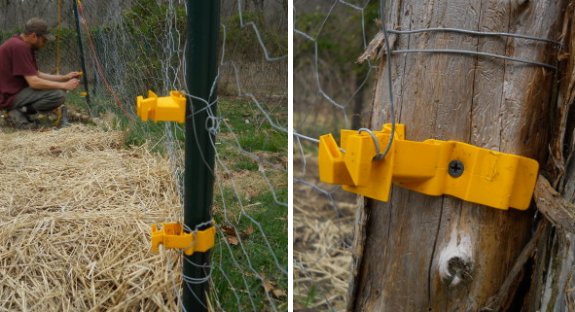
Electric fence problems
Lucy is still making holes in
the chicken pasture fence.
Arghhh...
When I tested the electric
fence line we installed today it seemed a little weak. I first
thought we might be reaching the limit of distance, but the
instructions say it should go up to 1500 feet.
I'm thinking I may have not
tightened down the wing nut enough where the two wires attach. Either
that or maybe the unit is suffering some sort of power decline?
Want more in-depth information? Browse through our books.
Or explore more posts by date or by subject.
About us: Anna Hess and Mark Hamilton spent over a decade living self-sufficiently in the mountains of Virginia before moving north to start over from scratch in the foothills of Ohio. They've experimented with permaculture, no-till gardening, trailersteading, home-based microbusinesses and much more, writing about their adventures in both blogs and books.
Want to be notified when new comments are posted on this page? Click on the RSS button after you add a comment to subscribe to the comment feed, or simply check the box beside "email replies to me" while writing your comment.


J --- I thought the same thing from looking at the picture, but there are actually two separate wires that are several inches apart. The wire around the post connects the chicken wire to the post, while the wire going up from the insulator is a couple of inches in front of the post and is going to another strand of wire on more insulators circling back around to complete the circuit. (I should have been more careful with my photography, cleary!) You're totally right that it would be a very bad thing if the electric wire wrapped around the chicken wire, but luckily this isn't the case.
Heath --- These K9 units are supposed to be special in that you don't have to ground them. I don't entirely understand how that works, but that's what the instructions say. Yup, all yellow insulators.
Dave --- Hopefully it's still enough to get Lucy's attention. It's less than it was previously, by Mark's tough-the-fence-and-swear meter.
Heath --- I'm not sure if she's been bad enough to test it yet. But no new holes, which is a good sign.
Disconnect the energiser from the fence and test between the terminals. This will give you the output energy available. Anything under 6000v is a bit rubbish. If the energy drops when you've connected it back to the fence then the fence is the problem. This is a link to a step-by-step sequence to check a fence. http://www.agrisellex.co.uk/information/trouble-shooting.html